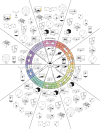Rodent models of post-traumatic stress disorder: behavioral assessment
- PMID: 32376819
- PMCID: PMC7203017
- DOI: 10.1038/s41398-020-0806-x
Rodent models of post-traumatic stress disorder: behavioral assessment
Abstract
Although the etiology and expression of psychiatric disorders are complex, mammals show biologically preserved behavioral and neurobiological responses to valent stimuli which underlie the use of rodent models of post-traumatic stress disorder (PTSD). PTSD is a complex phenotype that is difficult to model in rodents because it is diagnosed by patient interview and influenced by both environmental and genetic factors. However, given that PTSD results from traumatic experiences, rodent models can simulate stress induction and disorder development. By manipulating stress type, intensity, duration, and frequency, preclinical models reflect core PTSD phenotypes, measured through various behavioral assays. Paradigms precipitate the disorder by applying physical, social, and psychological stressors individually or in combination. This review discusses the methods used to trigger and evaluate PTSD-like phenotypes. It highlights studies employing each stress model and evaluates their translational efficacies against DSM-5, validity criteria, and criteria proposed by Yehuda and Antelman's commentary in 1993. This is intended to aid in paradigm selection by informing readers about rodent models, their benefits to the clinical community, challenges associated with the translational models, and opportunities for future work. To inform PTSD model validity and relevance to human psychopathology, we propose that models incorporate behavioral test batteries, individual differences, sex differences, strain and stock differences, early life stress effects, biomarkers, stringent success criteria for drug development, Research Domain Criteria, technological advances, and cross-species comparisons. We conclude that, despite the challenges, animal studies will be pivotal to advances in understanding PTSD and the neurobiology of stress.
Conflict of interest statement
The authors declare that they have no conflict of interest.
Figures

Similar articles
-
[Posttraumatic stress disorder (PTSD) as a consequence of the interaction between an individual genetic susceptibility, a traumatogenic event and a social context].Encephale. 2012 Oct;38(5):373-80. doi: 10.1016/j.encep.2011.12.003. Epub 2012 Jan 24. Encephale. 2012. PMID: 23062450 Review. French.
-
Current Status of Animal Models of Posttraumatic Stress Disorder: Behavioral and Biological Phenotypes, and Future Challenges in Improving Translation.Biol Psychiatry. 2018 May 15;83(10):895-907. doi: 10.1016/j.biopsych.2017.11.019. Epub 2017 Nov 20. Biol Psychiatry. 2018. PMID: 29338843 Free PMC article. Review.
-
Post-traumatic stress disorder and beyond: an overview of rodent stress models.J Cell Mol Med. 2017 Oct;21(10):2248-2256. doi: 10.1111/jcmm.13161. Epub 2017 Apr 4. J Cell Mol Med. 2017. PMID: 28374949 Free PMC article. Review.
-
Controlled Low-Pressure Blast-Wave Exposure Causes Distinct Behavioral and Morphological Responses Modelling Mild Traumatic Brain Injury, Post-Traumatic Stress Disorder, and Comorbid Mild Traumatic Brain Injury-Post-Traumatic Stress Disorder.J Neurotrauma. 2017 Jan 1;34(1):145-164. doi: 10.1089/neu.2015.4310. Epub 2016 Mar 30. J Neurotrauma. 2017. PMID: 26885687
-
Sounds of danger and post-traumatic stress responses in wild rodents: ecological validity of a translational model of post-traumatic stress disorder.Mol Psychiatry. 2023 Nov;28(11):4719-4728. doi: 10.1038/s41380-023-02240-7. Epub 2023 Sep 6. Mol Psychiatry. 2023. PMID: 37674017 Free PMC article.
Cited by
-
Molecular pathways underlying sympathetic autonomic overshooting leading to fear and traumatic memories: looking for alternative therapeutic options for post-traumatic stress disorder.Front Mol Neurosci. 2024 Jan 8;16:1332348. doi: 10.3389/fnmol.2023.1332348. eCollection 2023. Front Mol Neurosci. 2024. PMID: 38260808 Free PMC article. Review.
-
Electroacupuncture modulates glutamate neurotransmission to alleviate PTSD-like behaviors in a PTSD animal model.Transl Psychiatry. 2023 Nov 22;13(1):357. doi: 10.1038/s41398-023-02663-4. Transl Psychiatry. 2023. PMID: 37993441 Free PMC article.
-
The Evolving Role of Animal Models in the Discovery and Development of Novel Treatments for Psychiatric Disorders.Adv Neurobiol. 2023;30:37-99. doi: 10.1007/978-3-031-21054-9_3. Adv Neurobiol. 2023. PMID: 36928846
-
A short review on behavioural assessment methods in rodents.Bioinformation. 2023 Aug 31;19(8):866-870. doi: 10.6026/97320630019866. eCollection 2023. Bioinformation. 2023. PMID: 37908611 Free PMC article.
-
Sex, Pramipexole and Tiagabine Affect Behavioral and Hormonal Response to Traumatic Stress in a Mouse Model of PTSD.Front Pharmacol. 2021 Jun 30;12:691598. doi: 10.3389/fphar.2021.691598. eCollection 2021. Front Pharmacol. 2021. PMID: 34276379 Free PMC article.
References
-
- Kessler RC, Sonnega A, Bromet E, Hughes M, Nelson CB. Posttraumatic stress disorder in the national comorbidity survey. JAMA Psychiatry. 1995;52:1048–1060. - PubMed
-
- Kessler RC, et al. Lifetime prevalence and age-of-onset distributions of DSM-IV disorders in the national comorbidity survey replication. JAMA Psychiatry. 2005;62:593–602. - PubMed
Publication types
MeSH terms
Grants and funding
- R01MH098003/U.S. Department of Health & Human Services | NIH | National Institute of Mental Health (NIMH)/International
- RF1MH114224/U.S. Department of Health & Human Services | NIH | National Institute of Mental Health (NIMH)/International
- R01 NS085200/NS/NINDS NIH HHS/United States
- R01 MH098003/MH/NIMH NIH HHS/United States
- RF1 MH114224/MH/NIMH NIH HHS/United States
LinkOut - more resources
Full Text Sources
Medical

